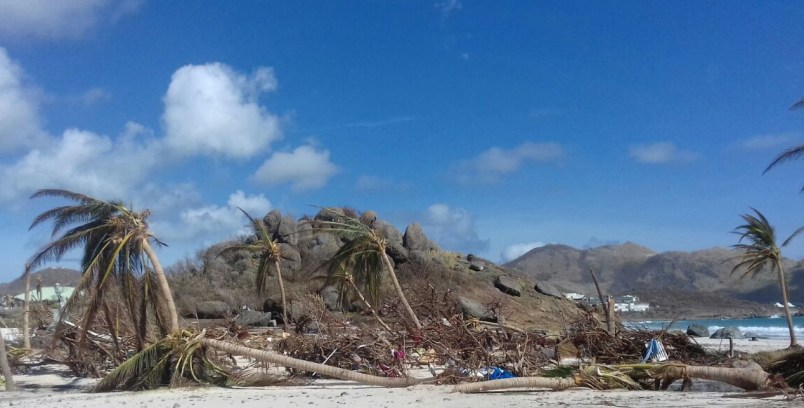PARIS (AP) — Some black and mixed-race residents of the hurricane-devastated French territory on the island of St. Martin are expressing anger at a perception that white tourists have been given priority during evacuations.
The anger over perceived discrimination exposes underlying racial tensions that have long plagued France’s far-flung former colonies — especially its Caribbean territories, where most of the population identifies as black, and is poorer than the white minority.
St. Martin resident Johana Soudiagom was disturbed to find herself among a tiny handful of non-whites evacuated on a boat to nearby Guadeloupe after Hurricane Irma ravaged her island.
“It’s selective. Excuse me, but we saw only mainlanders,” she told Guadeloupe 1ere television, visibly shaken. “That’s a way of saying, ‘I’m sorry, only whites. There are only whites on the boat.'”
It’s common practice for tourists to be evacuated first from disaster zones for practical reasons, as they are staying in hotels and not in their homes, and tend to have fewer resources such as food and vehicles. The French prime minister insisted Monday that the only people being prioritized are the most vulnerable.
Yet Soudiagom and other witnesses told Guadeloupe 1ere that the boat they took Friday carried tourists, including Americans, to safety but left many St. Martin residents behind, including needy mothers and children.
On Monday, France’s Representative Council of Black Associations wrote to the government asking for a parliamentary inquiry into the handling of the Irma recovery, amid concerns that those evacuated weren’t “necessarily the most in distress.”
“In my eyes, Irma is for the French Antilles what Hurricane Katrina was for Louisiana in the U.S. — an exposer of racial and social inequalities,” the group’s spokesman, Louis-Georges Tin, told The Associated Press.
The terror of facing down a Category 5 hurricane has combined with a long-held sense of isolation among local residents of St. Martin, some 6,700 kilometers (4,200 miles) from the French mainland and popular with European tourists.
“The natural catastrophe occurred in a place that’s very vulnerable socially, where there is a population of many different skin colors and a history of slavery,” said Michel Giraud, a French researcher who writes on race. “Of course there will be a perception of racism.”
The island of St. Martin — divided in the 17th century into the French territory of Saint-Martin and the Dutch territory of Sint Maarten — measures just 87 square kilometers (34 square miles). Its 80,000 residents are a vibrant ethnic mix descended mainly from Africa, Europe and Asia. The two sides of the island share a creole language that draws heavily on English vocabulary.
The French part of St. Martin is similar to other French holdings in the Caribbean in that its white minority is generally wealthier than its black majority. Because France bans the collection of data on race, there are no statistics to show how much wealthier.
It began as a colony whose economy was fueled by African slaves. But after slavery was abolished in 1848, Tin said, “there were no reparations for the slaves, only for the slave owners,” so the former slaves won freedom but remained destitute. “The economy is now based on tourism but it is still poor. The wages are significantly lower than the mainland France.”
The government isn’t the only one being accused of racial bias in the wake of the storm. Giraud said French television reports on the devastation focused disproportionately on white people.
“When I saw the pictures I was shocked,” Giraud said. “In the coverage I saw, the victims were mostly white tourists, or white French mainlanders. But the poorest are always the first victims.”
Irma hit St. Martin on Wednesday, killing at least nine people on the French part of the island and damaging a majority of its buildings.
The following day looters were seen hauling food, water and televisions from shops, and videos featuring predominantly black people raiding shops circulated online. Some took to social media to blame the thieving on non-whites, and characterizing the white evacuees as innocents escaping the chaos.
Tin said the island’s poorer residents were doing what they had to after an ineffective government response.
“What some call theft, others call survival,” he said. “When the state doesn’t do its job, it’s normal that the poorest do what’s necessary to survive.”
“In Florida there were more than 1 million evacuated, and France says that with four days’ notice they couldn’t evacuate a much smaller number,” Tin said. “The question must be asked, does it have to do with racism?”
The government argues that it is more difficult to transport tens of thousands of people off small islands in stormy weather than it is to tell people to drive to safety.
French President Emmanuel Macron will fly to St. Martin on Tuesday to inspect the damage and relief operations and to reassure the local population.
Christophe Castaner, the French government’s spokesman, said that he perfectly understands islanders’ anger with the government’s response — but blamed part of the controversy on their “emotional shock, an impact that’s extremely hard psychologically.”



